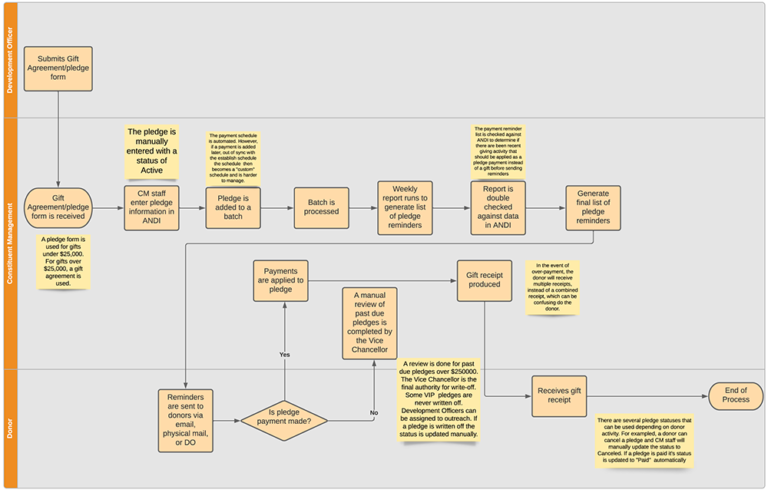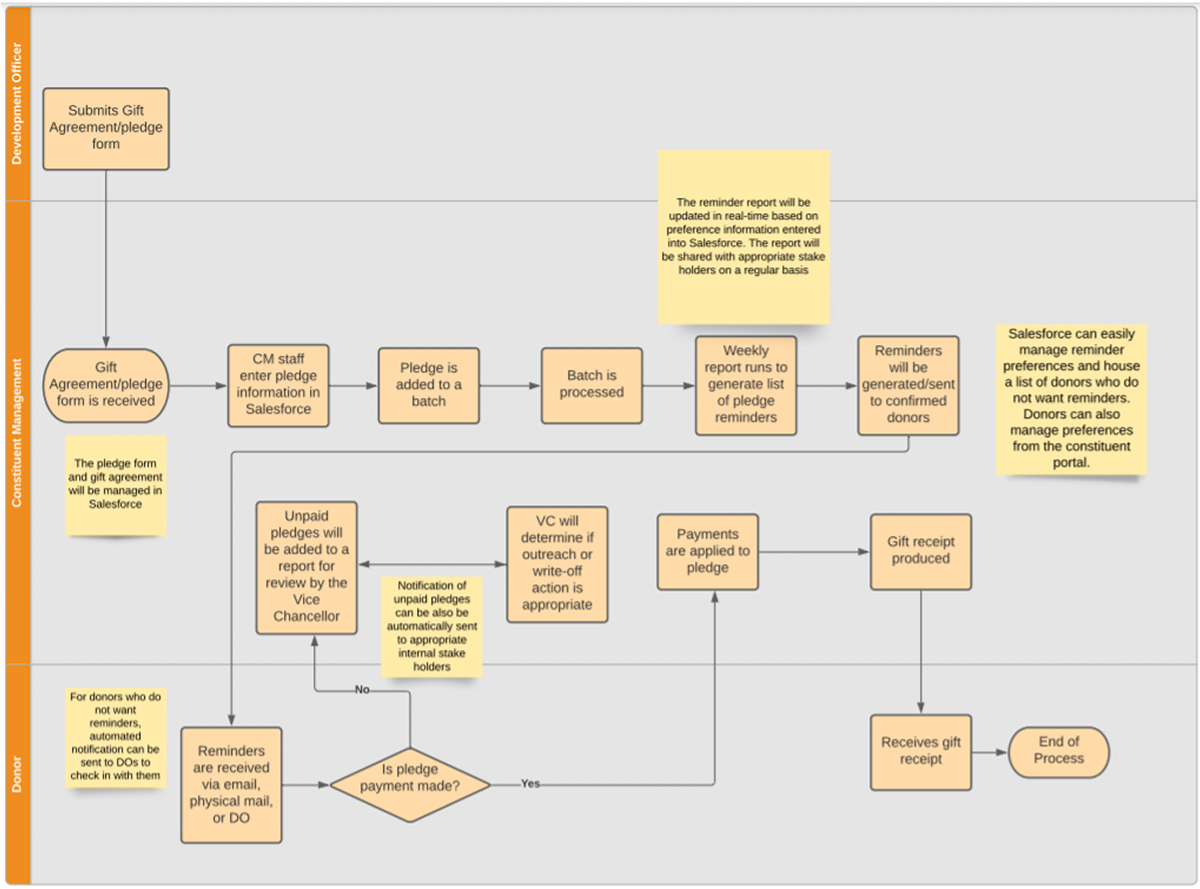Discovery Sessions
Process Overview
The lifecycle of a pledge includes the following stakeholders:
- Development Officers
- Constituent Management Department
- Donors
The Constituent Management Department is notified about new pledges through pledge forms or electronic gift agreements. If a pledge amount is below $25,000,a pledge form is completed. If the amount is $25,000 or more, it must be documented in a gift agreement. Once the Constituent Management team receives either a pledge form or gift agreement, the pledge is entered into ANDI through a batch.
A report is run weekly to generate a list of pledge reminders. The report is checked against data in ANDI to determine if a pledge reminder is due to be sentout to the donor. Once this list has been reviewed, pledge reminders are sent todonors who have requested to receive them. Some donors have indicated they do not want to receive reminders. Usually, these preferences require manual management and Constituent Management staff may reach out to the primary Development Officers to determine how reminders/notification should be addressed.
A pledgeâs status may change depending on donor activity. If a donor decides to cancel a pledge, he or she may reach out to indicate the cancellation. The pledge must then be manually updated with a status of âCanceledâ. The Constituent Management office sends a report of unpaid pledges to be reviewed bythe Vice Chancellor to determine if the pledge is to be written off, or if the primary Development Officer should be assigned to complete outreach to the donor. The Vice Chancellor has the final authority to write off a pledge. If a pledge is paid, its status is automatically updated to âPaidâ.
Once a pledge payment is made, a gift receipt is produced and sent to the donor. If a donor makes multiple payments at the same time, they will receive multiple receipts. When a donor makes an overpayment or multiple payments, the initial payment schedule is automatically updated to a custom payment schedule.

Opportunities
During discussion about the process, several improvement opportunities to address inefficiencies in the current state surfaced:
1. Proposal Assignment
- Constituent management staff must assign the proposal number to a pledge. However, this can often times be missing or hard to find.
2. Payment Scheduling
- The system automatically generates a payment schedule based on the amount ofthe pledge and the life of the pledge. However, occurrences like over-payments can generate a custom schedule that is not easily managed.
- It is difficult to facilitate payments that come in before the pledge is setup in the system
- Ideally, the system would have the ability to apply an overpayment to the overall pledge amount, thus lowering the amount of each installment but not changing the schedule. Another option would be to adjust the total number of payments. In the future, the Foundation would benefit from such flexibility.
- Staff need the ability to designate if a pledge payment is an outright gift,depending on donor intent.
3. Reminders & Receipts
- The process of determining which donors should receive reminders is report-driven and requires manual management; this process would be improved through automation.
- Unable to easily track in a report which donors do not want to receive pledge reminders. Special handling and custom notification processes for donors who do not want reminders is managed with the help of Development Officers and spreadsheets.
- Need the ability to combine receipts for donors who make pledge payments andgifts at the same time.
4. Reporting and Metrics
- There are currently limited dashboards, reports and metrics surrounding pledge fulfillment.
- Email reports are cumbersome; dashboards would help make reporting more readily accessible and easy for staff to utilize.
Final Summary
The process of entering in a pledge is complicated by system limitations surrounding payment scheduling, assigning proposal ID numbers, generating reminders and receipting, and a lack of well-established metrics. Assigning proposal ID numbers can often require research, which can be time-consuming. Onemajor pain point in the pledge process is that the system does not adjust well to donor behavior. If a donor overpays a pledge payment, there needs to be a wayto apply the overpayment to the overall pledge, thus reducing the amount due foreach installment and keeping the schedule intact.
Currently if a donor over-pays, pays toward future payments, or pays before apledge is entered, the system defaults to a custom schedule. The custom schedulemay impact the ability to remind donors of pledge payments or require manual work to correct the schedule. Constituent management staff would benefit from a system that can accommodate these donor behaviors and provide consistency.
Generating reminders is a manual process. Presently, once the reminder reportis received, it must be manually checked against ANDI to ensure its accuracy andavoid sending reminders in the case that a pledge payment was processed as a gift. The process of generating reminders is further complicated by instances ofdonors who do not want to receive reminders but still would like to be notified of impending payments.
The process will benefit from a CRM that can automate reminders and manage preferences and service indicators to exercise control of automated actions. In this way they will be able to benefit from the ease of automation and reduced manual reviews while still maintaining donor relationships that require special handling. The donor experience is further impacted negatively when they receive multiple receipts when making more than one payment at the same time. Concerningdonor preferences, donors will benefit from the ability to receive combined receipts for pledge payments and gifts. Lastly, the current system does not provide robust metrics related to pledge activity. The new CRM will provide the ability to track metrics such as pledge fulfillment, allowing more transparency and the ability to use data to adapt and take actions to meet goals.
Future State Process Overview
The Constituent Management department will be notified when pledges are established; pledges will either be established by the donor while working with a development officer or by making the pledge directly online. For pledges over $25,000 a gift agreement will be completed, and for pledges under $25,000, a pledge form will be completed, all housed in Salesforce. Once the Constituent Management is notified of the pledge information, the data will be entered in a batch to be processed, which will save the pledge information to the constituentâs record.
A report, housed in Salesforce, will run weekly to generate a list of pledge reminders. The report will be updated in real time and segregate out any donors who have requested that no reminders be sent. The reminder report will be available to internal stakeholders wanting to review the information, via sharedreports, dashboards, or scheduled to be delivered via email. Pledge reminders will be automated to be sent to donors who have requested to receive them. Development officers will use the report of donors declining reminders to conduct appropriate outreach to drive the payment of pledges.
A pledgeâs status may continue to change depending on donor activity; if a donor decides to cancel a pledge, he or she will reach out to indicate the cancellation. The pledge will be manually updated with a status of âCanceled.â Unpaid pledges will be captured on a report available to the Vice Chancellor whowill continue to have the final authority to write off a pledge or assign development officers to outreach tasks. If a pledge is paid, its status will be automatically updated to âPaidâ and the transaction will be related to the pledge.
Once a pledge payment is made, a gift receipt will be produced and sent to the donor. If a donor makes multiple payments at the same time, a combined receipt will be issued, detailing all the payments. When a donor makes an overpayment or multiple payments, staff will determine whether to apply the overpayment to the overall pledge amount (keeping the payment schedule intact and reducing the amount of each payment) or applying the overpayment to the upcoming payments, thus reducing the number of outstanding installments.
In the future, pledges will be easily adjusted to meet donor needs/changes and the appropriate tracking of those adjustments will be kept in the system.
Key changes
During discussion about the process, several improvement opportunities to address inefficiencies in the current state surfaced:
1. Proposal Assignment
- In the current state, constituent management staff must assign the proposal number to a pledge.
- In the future state, proposals will be easily associated with pledges.
2. Payment Scheduling
- Currently, the system automatically generates a payment schedule based on the amount of the pledge and the life of the pledge, but over-payments can generate a custom schedule that is not easily managed.
- In the future state, staff will have the ability to apply over payments to the overall pledge amount without changing the schedule
- Presently, staff need the ability to designate if a pledge payment is an outright gift, depending on donor intent.
- In the future, staff will be able to designate if a payment is an outright gift or pledge payment.
3. Reminders & Receipts
- In the current state, the process of determining which donors should receivereminders is report-driven and requires manual management.
- In the future state, reminder preferences will be managed by automation, with Salesforce housing preferences and segregating them into separate reports that inform communication activity.
- In the current state, constituent management staff need the ability to combine receipts for donors who make pledge payments and gifts at the same time.
- Salesforce will offer the ability to combine receipts for payment and gifts.
4. Reporting and Metrics
- There are currently limited dashboards, reports and metrics surrounding pledge fulfillment.
- In the future state, reports and metrics will be housed in Salesforce; dashboards will be readily accessible and easy for staff to utilize.
Considerations
- What pledge information do you want to be visible to donors when they log into the constituent portal? What actions should donors be able to take related topledges?
- Who should be able to adjust a pledge amount, payment schedule? Is there a need to a process flow to request an adjustment to a pledge?
- What reporting capabilities would campuses and the foundation like to see related to pledges? Are there certain reports that will allow for driving towards higher pledge fulfillment?
Final Summary
The future process of entering and maintaining pledges will remedy many of the complications in the current system surrounding payment scheduling, assigning proposal ID numbers, generating reminders and receipting, and a lack of well- established metrics. Proposal ID numbers will be attached to pledges automatically. When a donor overpays a pledge payment, staff will have the ability to apply the overpayment to the overall pledge amount, reducing the amount due for each installment and keeping the schedule intact. This will reduce the amount of manual effort expended to manage payment schedules.
Generating reminders will become an automated process. In the future, a reminder report will be maintained in Salesforce and will be available for weekly distribution to internal stakeholders. Another report will also indicate which donors do not want to receive reminders, even though they have payments due. The reminders will be segmented to ensure only the donors who have requested reminders will receive them. Salesforce will automate reminders and manage preferences and service indicators to exercise control of automated actions. In this way, Salesforce will provide the benefit of automation and reduce manual reviews. The report capturing donors who do not want reminders will be shared with Development Officers to facilitate special handling. Donors will also benefit from the ability to receive combined receipts for pledge payments and gifts. The new CRM will provide the ability to track metrics such as pledge fulfillment, allowing more transparency and the ability to use data toadapt and take actions to meet goals.


